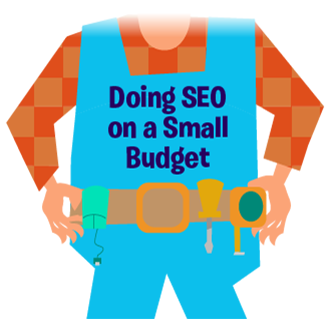Doing SEO requires time, effort and money. If you run a business with a website (and who doesn’t have one today?), then you probably know you should be doing something to boost SEO.
However, what if you have a small budget? You can still do it; it only demands more effort and more DIY work.
Many business owners use excuses that it is expensive to build SEO as a reason to ignore SEO. Still, they do not realise that SEO is more cost-effective than many other marketing forms.
There is no need to spend thousands of dollars every month on SEO strategies.
With a few simple things such as optimising content, images and your website, that we will discuss later, you can get the search traffic that you need on a tight budget.
In this article, we will answer the big question on everyone’s mind – how to do your SEO when you’re on a limited budget?
Firstly, you’ll need to carry out a self-assessment for any issues, then plan a local SEO plan, optimise for long tail keywords and so on. Stick to our article, and you will find out more.
Why Is SEO Important?
Low quality and poorly optimised web pages can result in lower website rankings, and with the weak user experience.
That holds true for content as well. In fact, that will prevent visitors from returning to your site, and therefore you will have a high bounce rate and a bad rating for search crawls.
By optimising your pages, publishing new content and optimising your website – you are on a good way to the top of the search engine result pages.
One important thing to keep in mind – Google’s optimisation is the most effective marketing possible.
If you are first on search results when someone searches for what you sell or do, it means that anywhere on planet Earth when someone is looking to buy your product or service that comes to you.
Most visits to a site come via major commercial search engines such as Google, Yahoo, or Bing. Many social networks that are popular today can help increase the number of visitors to your site, but they cannot replace the search engines.
A good search engine ranking position (SERP) will mean a dramatic increase in the amount of traffic onto your site, regardless of whether it offers services, products, information, or is dedicated to anything else.
A higher number of visits will ultimately increase your revenue, via your online store or company website that is presented to you. With finely tuned SEO optimisation and high-quality content, you can potentially experience even higher returns.
If search engines cannot find your site or its content isn’t included in their database, you miss a unique opportunity to present your products, services, or any other material to a large number of people.
1. Focus On Local Search
First thing first – local SEO needs to be in your perspective. Start by thinking locally, and afterward gradually grow your presence regionally.
If you are based in the UK, start by growing your SEO presence in your town or city. Start with small steps, think big and work your way up to gain presence across the country or even the EU region.
Local SEO is an excellent way to grow your search rankings, especially if your budget is limited.
A good beginning point is to open your Google My Business account. That is quite simple, and also a something you can do for free that will make you relevant in local searches.
Fill out all of your business information such as business hours, location, photos and all other information (do not skip fields!).
A significant advantage is – you can also post there (for example pictures, texts or events), and that will show up on your Google My Business profile.
Be accurate and informative and place a few relevant keywords as well. Choose the specific category of your business and match it with your keywords.
It only takes a few minutes to open and set your Google My Business account, but this can have a major impact on your SEO. Your business will have a listing on Google, and it will appear in local searches.
2. Target on long tail keywords
To do your SEO right, you first need to get to know your customers – their needs, wants, questions and so on.
Knowing this will allow you to narrow specific and longer phrases that potentially bring your particular audience on your site.
The benefit of long tail keywords grants you to communicate with your target audience, but also another perk is lower competition than on general keywords.
The long – tail keyword will very specifically target your customers’ needs.
If you have a limited budget, it is best to focus your SEO on long-tail keywords than on general competitive keywords. After all, long – tail keywords will help small business to reach a much narrower audience.
Long – tail keywords are excellent for driving both traffic and conversions – and giving your SEO much wanted boost.
3. Improve your Web Site
The root of any SEO strategy is to build up the user experience and rank the website higher.
When a user gets on your website, the first reaction is created by how your website looks. So, it is all about that first impression created by your website design!
That is why it’s crucial to leave an amazing first feeling of your website.
Google will appreciate and prioritise a superb user experience, so make sure your web page doesn’t have any mistakes.
By that we mean – fixing all 404 errors so there are no dead ends or useless sites. Moreover, clean your URL, so they are easily readable and remove any redundant or not relevant content.
Also, you need to tell the search engine what your site is about. Make sure to add headings, meta descriptions, URL and keywords to the content of each page and category on the site.
Create separate pages for each distinct product or service that you are offering, and use the appropriate keywords in each of these pages.
However, be careful about overstuffing your content with keywords in an attempt to get a better ranking.
Focus on writing your content like you’re talking to a real person, do not write for search bots.
These rather simple steps can be fixed up in a day or two, but will make a visible impact on your SEO over long-term.
If you have the resources, you can go even further – by focusing on creating easy navigation on your site, improving the speed of your site and optimise it for mobile.
4. Create Great Content and Optimise It
On-page optimisation is a critical part of success in SEO. That is an excellent place to start with when doing your SEO on a budget.
An additional benefit is that this is something you can completely control, and you can see the results faster than on any other activity.
Start by optimising your home page, and then move to less useful pages.
Look at your content and additional terms that are related to your post – this way search engines will understand your topic better.
Next thing you need to do is publish fresh content on a regular basis. Doing this you will improve your website’s ranking in search results. Why is that?
That’s because every time you add new content to your site, Google’s web crawler will visit your website and index it. The more often you add new content, the more often web crawler will visit your website and reanalyse it.
Also, the more pages are optimised, and with quality content, the more are the odds for people to find you on search engines.
It’s significant to say that the web crawler will not boost your site only because your content is new. (You planned to get lazy now, did you?)
The content you produce still must be high quality, relatable, valuable and relevant to your audience and expressed to make an impact on them.
So, the math is simple: post high quality and relevant content + post frequently = web crawler will realise your website is valuable for people searching for your target keywords.
5. Don’t Forget Your Images
Since you are optimising, optimise your images too!
Image optimisation is also an essential part of your SEO strategy. To optimise images in the best manner, make sure you include proper image metadata with relevant keywords and phrases.
Few easy ways you can optimise your images:
- Alt tags: Alt tags serves as an explainer of what the pictures on the web site should display. So, when there’s a slow Internet connection, or if text-reading software is being used, alt tags are used as alternate text.
- Image tags: Image tags provide additional context to an image, you can usually see it when an image is scrolled over.
- Filename: The file name goes deeper in providing context—more specifically, how the image relates to the other content on the page.
Search engines are seeking for relevant keywords within file names, so make sure your filenames are related and contain relevant keywords.
By optimising the images in your content, you will potentially gain better rankings in the search engines.
That makes the difference between bringing more traffic to your website and missing out on reaching a massive audience.
Some Common SEO Mistakes to Avoid
Mistakes can be painful AND expensive, so here are some of the most common SEO mistakes you should avoid making, especially when you’re on a budget.
Low-quality content
Poor content and not thinking about your users is a common mistake.
The answer to this mistake is: generate great content by talking and listening to your audience. Use the content to reply to their questions with useful data, tips, and visuals.
Always keep in mind your audience in mind when you’re creating and publishing content.
Treating SEO As A One-Time Job
Many small or new businesses treat SEO as a thing they need to do once and then forget about it. Identically many have the impression that only with technical optimisations, their websites can achieve SEO-friendliness.
Every company or business should continually expand the extent of their websites with highly relevant content about their products and services that will influence user feedback, more traffic, and a better search position.
Indexability issues
This one is easy: If a page can’t be indexed, it won’t be included in the search results. From blocked and missing pages to broken links and redirects can cause indexability issues. What is crucial is to monitor each page of your web consistently. If a search engine cannot visit your page, neither can your visitors. As a result, the page won’t become indexed or viewed, and that can cause an increase in bounce rate and a decrease in organic traffic.
In conclusion
As you realised by now, you don’t need tons of money or tools to do your SEO.
In fact, when it comes to SEO, time and effort is the currency you’ll need to achieve success, not money.
By implementing our affordable SEO tactics, you can increase your search engine ranking and make it easier for your users to find you.
Following these simple SEO practices, any website or business can improve their search engine position and generate more traffic and sales.
From bad links and poor user experience to irrelevant descriptions or lousy content, many setbacks are fixable through basic SEO practices. Use our easy tricks such as optimising content, focusing on local searches, updating your content and your website your budget will stay untouched.
It only takes time and effort to see the results of your hard work. Easy to say than do, right?
Anyhow, be sure search engines will appreciate all of these improvements and rank your page higher.
Always consider your SEO is a part of an ongoing digital strategy that can be changed and improved depending on audience needs and search engine updates.







